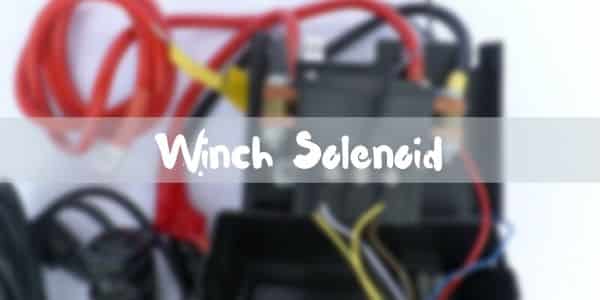Last Updated on June 21, 2021
Before going to buy a winch you need to know about the parts and accessories of a winch. Winch power and durability depend on its parts. A heavy durable part of a winch will gift a durable life to a winch.
In a word, you should know everything about winch parts.
Winch solenoid is also one of those parts. Today in this article, I am going to tell you everything you should know about a winch solenoid. I will try to cover – what is a winch solenoid? What is its responsibility? How to mount a winch solenoid? 2 or 4 solenoids? Advantages and disadvantages of winch solenoids and at last how to test a winch solenoid.
Stay with me till the finish. After going through this article, you will have a clear idea about winch solenoid.
Read More:
Quick Navigation
What is a Winch Solenoid and How It Works?
Generally, a winch solenoid is an electromagnetic switch. Normally, It is used for activating the motor of a winch that is mounted on the vehicle. The most important feature of this winch solenoid is- it supplies the necessary current without having any type of loss to the winch motor. A winch solenoid is associated with solenoid, mounting bolts and control cable.
A winch solenoid ensures safety in the use of a winch by locking the external leakage and also controlling the internal leakage.
Mounting a winch solenoid
Well, Mounting solenoid should be the most prioritized considerations among lots of considerations. Your winch may have two types of solenoid pack. Either an Integrated solenoid pack or a remote solenoid pack.
A remote solenoid is known as externally mounted off of the winch. This is the plus point of the remotely mounted solenoid as it saves space. A remote solenoid pack needs less room. That’s why it is easy to hide behind a bumper or brush guard as well as more protected from damage. Moreover, the winch motor used to produce excessive heat. Remote solenoid protect the winch from this excessive heat
On the other hand, the integrated solenoid is part of the winch either within a bridge over the cable or mounted elsewhere above the motor. This type of solenoid pack requires excessive wiring. The integrated solenoid pack is also responsible for creating a short in the electrical systems as it decreases the opportunities for chaffing a wire.
2 or 4 solenoids
You may have noticed that some winches come with two solenoids and the rest of the winches come with four solenoids. There are some differences between them.
As usual, the four solenoids are more powerful than the two solenoids. Because the configurations of four solenoids are heavier, reliable and lighter. Top quality winches generally use four solenoids.
On the contrary, the two solenoids are configured typically that are found in the permanent magnet of some winches. Two solenoids are comparatively less impotent, less principled and also cheaper.
Well, there are both advantages and disadvantages to winch solenoid too. In spite of some disadvantages, there are lots of advantages to a winch solenoid. Ther are:
Advantages
- The function is simple and easy to use.
- First response, small power consumption and light-weight.
- Block the external leakage and also control the internal leakage of the winch for ensuring safety.
Disadvantages
- Solenoids have a difficult time with contaminated or dirty gases.
- The control signal must stay on during operation.
How To Test A Winch Solenoid
Testing a winch solenoid is not a big deal. It can easily be done by following steps. But before getting started you should go through some warnings and also you need some tools.
Tools required
- Screwdriver set
- Voltmeter
- Wire brush
Precautions
Before removing the solenoid cover plate never forget about disconnecting the battery. Battery power is good enough to make an electric shock.
Step 1: Before getting started you should make proper checking of the cable that goes to the battery from the winch solenoid. You may find the cables looking frayed, that time you have to replace them. Otherwise, if the cable is looking corded, you just need to clean them using a wire brush.
Step 2: Your next task is to disconnecting the positive(that comes along the red color) winch cable the battery. Then use the screwdriver for unscrewing the cover of the solenoid. You should be careful about the solenoid’s cable connection. In this stage, You may hear a noise like clicking whenever you will turn the winch because of the loose wire.
Step 3: Now your next task is to turn the winch off and then touching to the large studs using a voltmeter on the solenoids. you will find the large studs on the solenoids aside. If everything is going well, then the voltmeter will show 12. This means the solenoid is working properly.
Step 4: After testing the large studs, it’s time to test the small studs. You will find the small studs on the reverse to the winch side with the winch above. Test the small studs and see what the voltmeter shows, if the voltmeter is showing 12V as it showed in the previous step, then there is something wrong and it is not going well.
Step 5: After that turn the winch on. After turning the winch on, your task is testing the big studs using another voltmeter. There should not be any reading in OHM.
Step 6: Now you need to measure the OHM reading of the small studs using the voltmeter. You will see there is no reading if the solenoid is not working properly. That means the small studs are activated when the winch got power.
I hope this article helped you to clear the confusion about solenoid. If you think my article helpful, you can share this on your timeline.
By the way, you may also like to read my guide on wiring a winch without solenoid.


I’m Daniel Galbreath, founder of OffRoadersWorld.
I spend my spare time writing on this website, OffRoaders World. I share my thoughts and reviews on different types of gears, share tips sometimes. This website is specially created and regularly updated basically to help other folks like me when I started to solve the various problems they face, specially when they go off-roading.
